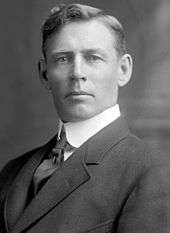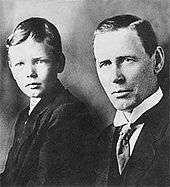Charles August Lindbergh
- This article is about the politician from Minnesota. For his son, the aviator, see Charles Lindbergh.
| Charles August Lindbergh | |
|---|---|
 | |
| Member of the U.S. House of Representatives from Minnesota's 6th district | |
|
In office March 4, 1907 – March 3, 1917 | |
| Preceded by | Clarence Buckman |
| Succeeded by | Harold Knutson |
| Personal details | |
| Born |
Carl Månsson January 20, 1859 Stockholm, Sweden |
| Died |
May 24, 1924 (aged 65) Crookston, Minnesota, United States |
| Resting place | Lakewood Cemetery |
| Political party | Republican |
| Spouse(s) | Mary LaFond, Evangeline Lodge Land Lindbergh |
| Children | Lillian Lindbergh, Eva Lindbergh, and Charles Lindbergh |
| Alma mater | University of Michigan Law School |
| Religion | Lutheran |
Charles August Lindbergh (born Carl Månsson; January 20, 1859 – May 24, 1924) was a United States Congressman from Minnesota's 6th congressional district from 1907 to 1917. He opposed American entry into World War I as well as the 1913 Federal Reserve Act. Lindbergh is best known as the father of famous aviator Charles Lindbergh.
Early life

Lindbergh was born Carl Månsson, in Stockholm, Sweden, to Lovisa Carlén, the 19-year-old mistress of Ola Månsson, a peasant member of the Riksdag of the Estates and a bank manager. When accused of bribery and embezzlement, Ola Månsson changed his name to August Lindbergh, left his wife and seven children, and emigrated to the United States with his mistress and their illegitimate infant son, Carl, in 1859. Lovisa became Louisa and young Carl became Charles August Lindbergh.
They settled in Melrose, Minnesota, and had six more children. August worked as a farmer and a blacksmith for 26 years before marrying Louisa in 1885; he had become a widower in 1864 with the death of his first wife in Sweden.[1][2]
Charles August Lindbergh studied law at the University of Michigan Law School, graduating in 1883 and being admitted to the bar the same year. In 1887, Lindbergh married Mary LaFond, with whom he had two daughters, Lillian and Eva. Mary LaFond died in 1898.
In 1901, Charles married Evangeline Lodge Land (1876–1954). They separated in 1918, their only child being the famous aviator Charles Lindbergh, who also became an antiwar leader.[2]
Political career
Lindbergh served as prosecuting attorney for Morrison County, Minnesota in 1891-1893. He was elected to the U.S. House of Representatives in 1906 as a Republican, serving in the 60th, 61st, 62nd, 63rd, and 64th congresses. In 1916 he unsuccessfully campaigned for a seat in the United States Senate. At the time of his death, Lindbergh was a candidate for governor on the Minnesota Farmer-Labor Party ticket, and would have been the first Minnesota governor from the party if he had been elected.
In 1913 he published Banking, Currency, and the Money Trust.[3] By 1917, third year of the Great War, Lindbergh's son was age 16, which meant some possibility of conscription. He wrote a polite, anti-war polemic entitled "Why is Your Country at War?". Hot off the press, a copy was rushed to President Woodrow Wilson. After examination, Wilson ordered the confiscation of all possible copies. Agents carrying out this order found pallets of the lead plates for printing, which were melted in a refiner's fire. This insult to the Lindbergh family is one basis for the original opposition of his son to U.S. participation in World War II. Eustace Mullins documents that plates of this book were confiscated and destroyed.[4]
Also in 1917 Lindbergh brought articles of impeachment against members of the Federal Reserve Board including Paul Warburg and William Proctor Gould Harding, charging that they were involved "...in a conspiracy to violate the Constitution and laws of the United States..."[5]
Charles August Lindbergh died in 1924 in Crookston, Minnesota of brain cancer. He has a memorial plaque in the columbarium at Lakewood Cemetery in Minneapolis. According to his wishes, son Charles scattered his ashes over the place near Sauk River where the first Lindbergh home once stood.[6]
Famous quotes
- "This [Federal Reserve Act] establishes the most gigantic trust on earth. When the President Woodrow Wilson signs this bill, the invisible government of the monetary power will be legalized....the worst legislative crime of the ages is perpetrated by this banking and currency bill."[7]
- Also quoted as:
- "This Act establishes the most gigantic trust on Earth. When the President signs this bill, the invisible government by the Monetary Power will be legalized, the people may not know it immediately but the day of reckoning is only a few years removed.... The worst legislative crime of the ages is perpetrated by this banking bill."
- "A radical is one who speaks the truth."[7]
- "The Aldrich Plan is the Wall Street Plan. It means another panic, if necessary, to intimidate the people. Aldrich, paid by the government to represent the people, proposes a plan for the trusts instead." The Aldrich Plan (History of central banking in the United States) was a forerunner to that which spawned the Federal Reserve.
- "To cause high prices, all the Federal Reserve Board will do will be to lower the rediscount rate..., producing an expansion of credit and a rising stock market; then when ... business men are adjusted to these conditions, it can check ... prosperity in mid career by arbitrarily raising the rate of interest. It can cause the pendulum of a rising and falling market to swing gently back and forth by slight changes in the discount rate, or cause violent fluctuations by a greater rate variation and in either case it will possess inside information as to financial conditions and advance knowledge of the coming change, either up or down. This is the strangest, most dangerous advantage ever placed in the hands of a special privilege class by any Government that ever existed. The system is private, conducted for the sole purpose of obtaining the greatest possible profits from the use of other people's money. They know in advance when to create panics to their advantage, They also know when to stop panic. Inflation and deflation work equally well for them when they control finance."[8]
References
Notes
- ↑ Hertog, Susan (1999). Anne Morrow Lindbergh: Her Life. Nan A. Talese, Doubleday. ISBN 0-385-46973-X.
- 1 2 "CHARLES A. LINDBERGH AND FAMILY: An Inventory of Their Papers at the Minnesota Historical Society". Minnesota Historical Society. 1987-08-18. Retrieved 2007-01-31.
- ↑ Lindbergh, Charles A. Banking, Currency, and the Money Trust. archive.org.
- ↑ "On Reclaiming Our Central Bank And Monetary Policy". PublicCentralBank.com. Retrieved 2007-01-31.
- ↑ Congressional record of Charles Lindbergh Sr., 1917, pp. 3126–3130
- ↑ Lindbergh, Charles A. An Autobiography of Values, 1976, p.90.
- 1 2 Charles A. Lindbergh Sr. Quotes, liberty-tree.ca
- ↑ Lindbergh, Charles August (1916). Real Needs, Volume 1, Issue 1. University of Minnesota. p. 83.
Bibliography
- Larson, Bruce L. Lindbergh of Minnesota: A Political Biography. New York: Harcourt Brace Jovanovich, Inc., 1973. ISBN 0-15-152400-9.
- Lindbergh, Charles A. An Autobiography of Values. New York, 1976.
External links
- The Charles A. Lindbergh and Family Papers are available for research use at the Minnesota Historical Society.
- United States Congress. "Charles August Lindbergh (id: L000320)". Biographical Directory of the United States Congress.
| United States House of Representatives | ||
|---|---|---|
| Preceded by Clarence Buckman |
Member of the U.S. House of Representatives from Minnesota's 6th congressional district 1907–1917 |
Succeeded by Harold Knutson |